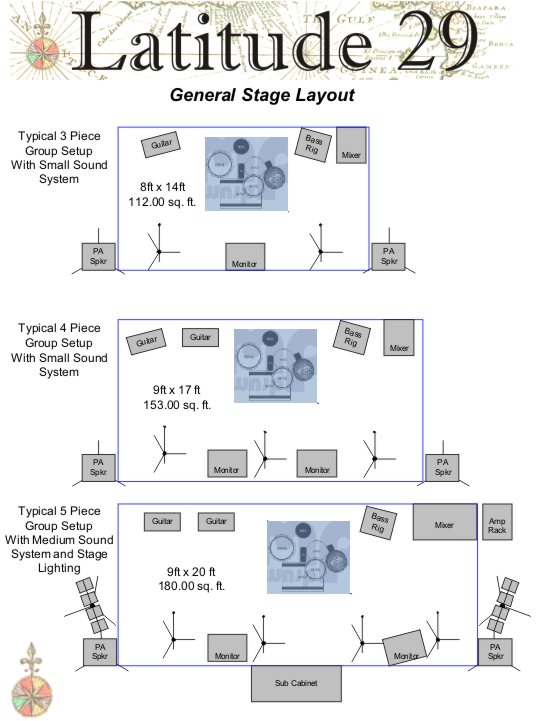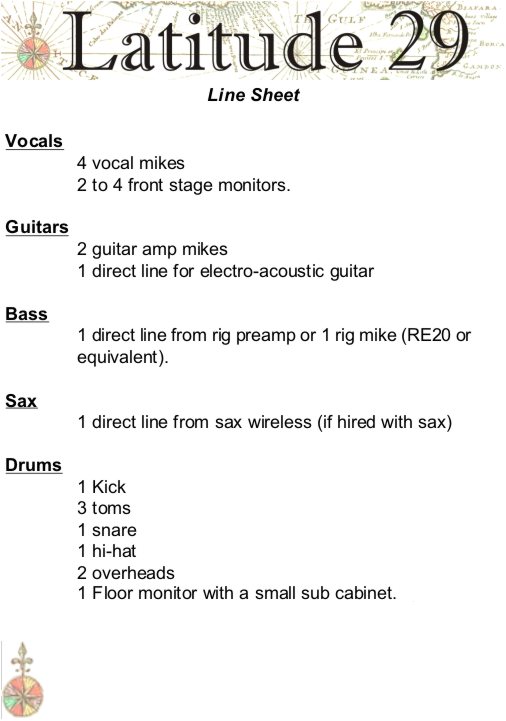Latitude29 Helpful Tips For A Headache Free Event
For the uninitiated, hiring a Live band can be very stressful. However with a little planning you can keep things running smoothly, safely, and eliminate most of the potential “bumps in the road”. Having survived many near disasters, we would like to share the following suggestions to help you plan a trouble free event.
If you don't feel these hints apply to your situation, just contact us and we will be happy to answer any questions you have. And don't worry – we've probably done it before.
Power Requirements
- For small events with no stage lighting at least one UNSHARED 15A, 120V electrical branch circuit will be required within 75 ft. of the area you expect the band to setup. This means there should be no lighting, food heaters, or anything else sharing the breaker with the band – many devices can cause the sound system to buzz or hum.
- For medium sized events (typically 100 to 500 attendees) where you would like a larger sound system and stage lighting you should have a minimum of 2 UNSHARED 15A, 120V electrical circuits (one for sound, one for lights) within 50 ft. of the area you expect the band to setup.
- For large events (typically greater than 500 attendees) or festivals please contact us for special sound and lighting arrangements.
- Request specifically that someone inspect the condition of all electrical outlets and fixtures in your guest service area for damage or improper grounding – the last thing you want is a guest with an electrical shock injury.
-Branch Circuit: means a 15A breaker feeding one or more outlets.Floor Requirements
- In general the band will need a solid stable dry floor to support us and our equipment. It will need to be strong enough to take us jumping, stomping, bouncing, etc.
- Sound equipment cannot be set up on uncovered ground (soil or sod) – this causes excessive wear to our equipment and is generally unsafe. If you need the group to setup outside you should provide as a minimum floor: sheets of plywood (see dimensions below) with some kind of covering stapled to the top to tie them all together. A rented dance floor can be assembled to create a suitable, simple, and economical surface.
- You should plan for approximately the following minimum area according the group size you plan to hire (see layout drawings near the bottom of the page):
-2 piece - 4'x8' to 6'x10'
-3 piece - 8'x14'
-4 piece – 9'x17' (12'x20' is better)
-5 piece – 9'x20' (12'x24' is better) - Additional area will also be required for speakers and stage lighting for medium and large events. Typical layouts to help you plan are near the bottom of the page.
- If the needed area is not available, please contact us so that we can make appropriate arrangements and adjustments.
- Avoid decorations around the dance floor and band area that might fall over if bumped or that someone might trip over – in fact you should expect someone to trip over and run into anything you put around the dance floor. Remember – “America's Funniest Videos” will not air anything in which someone is hurt.
Shelter / Enclosure Requirements
- Night Events
-We will not setup “under the stars” if there is ANY chance of rain. If your event is outside it is advisable to rent an appropriately sized frame tent for the band to setup under.
-If rain is possible (and it generally is) you should provide a frame tent with 3 sides for rain protection. If you have your seating, dance, and other areas under a large tent you should provide sides where the band will set up. These sides can generally be draped open for air-flow, and closed quickly if it begins to rain. - Day Events
-If yours is a daytime event you should provide a frame tent with 3 sides for rain and sun protection. Neither us nor our equipment perform well in direct sunlight.
- Night Events
Sound Levels (Volume)
- We strive to keep our volume appropriate for “what's going on” and frankly we prefer not to play excessively loud. However, we've also learned that you can't please everyone. This is primarily because what is perceived as loud varies greatly from one person to another.
- During dinner sets we will play soft enough that people can converse normally.
- We are a live band with real drums, etc. Expect us to be “fairly loud” especially during the final sets, when people are dancing.
Making Your Agenda Flow
For a 4 hour show we normally play 4 sets with 15 minute breaks. For example if you ask us to start at 7 PM the schedule would normally look like this:
1st Set -- 7:00 PM -- 50 min.
Break -- 7:50 PM -- 15 min.
2nd Set -- 8:05 PM -- 50 min.
Break -- 8:55 PM -- 15 min.
3rd Set -- 9:10 PM -- 50 min.
Break -- 10:00 PM -- 15 min.
4th Set -- 10:15 PM -- 50 min.
Finish -- 11:00 PMWeddings
- Decide on a simple agenda and type it up for us. Try to get your announcements, cake cutting, first dance, toasts and speeches, flower throwing, and garter flinging out of the way quickly at the beginning – allow about 5 to 10 minutes for each event. This will leave you time to have fun and visit with your guests.
- Have a trusted friend designated to work with the band (tell us when you are ready to be announced, etc) so you don't have to worry about it.
- We usually start weddings with music that most grandparents will enjoy – classics like “Under The Boardwalk”, “My Girl” and other easy listening material. As the evening progresses (dinner is finished, people are ready to dance) we move to “medium” dance material, and then later the rock and funk material.
- Avoid picking songs off the list that you don't want us to play. We will abide your wishes if you do, but most of the time we end up playing them anyway because they get requested by the guests. And when we lean over and ask the wedding party if we can play the song that the bride's uncle requested the answer is nearly always “sure... go ahead”.
- Avoid having a friend or relative sing or play a song with the band. It doesn't work like on TV – it always goes badly. We've seen only one exception to this.
Corporate Functions
- Decide on a simple agenda and type it up for us.
- Try to have your drawings, speeches, and announcements early in the night. It usually works well to do these during a meal as well.
- Plan your drawings, skits, or announcements, during our breaks. Why?
-They usually take longer than you think they will.
-It's better to do this when we aren't on stage with guitars (during breaks we can help you get people on and off the stage safely).
-This allows people to be engaged while taking a break from dancing.
-It can be difficult to get people dancing again after a lengthy interruption.
-We end up playing a lot more – you get more for you money!

